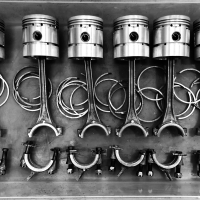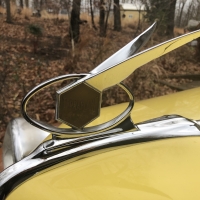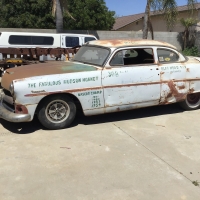Question about 1937 gasoline sender
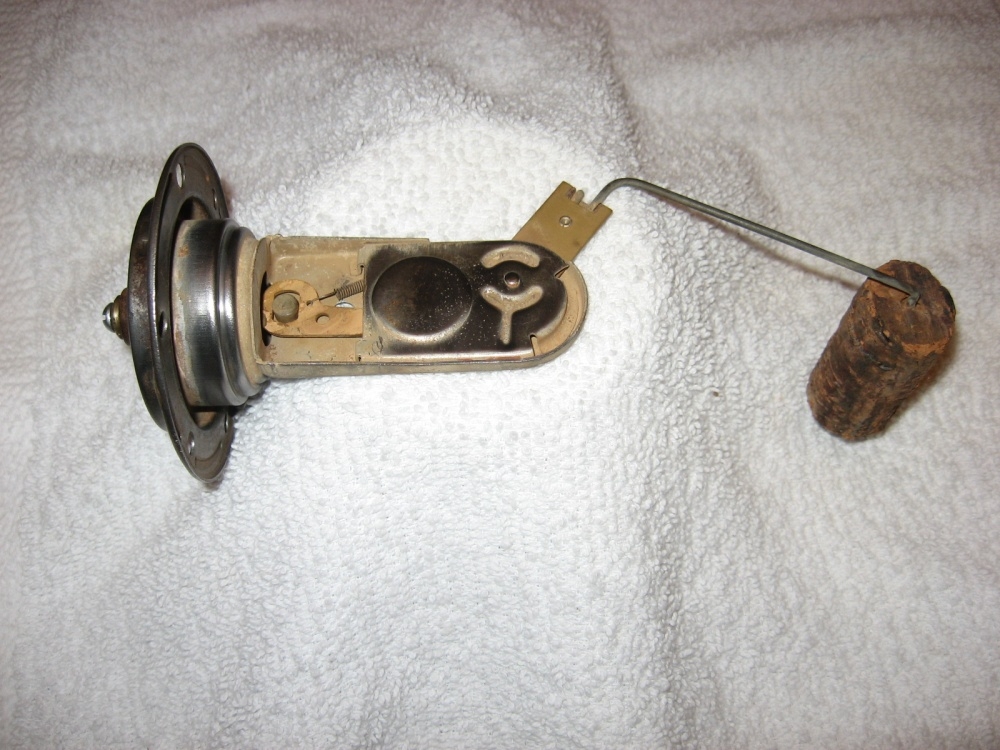
Is this a gasoline gauge sender for a 1937 Hudson or Terraplane? I seriously doubt that it is, but it was in my '37's gas tank for decades before it failed. If you have a '37 sender, could you please let me know if it matches this one?
If you do have an authentic '37 sender (one that is not presently installed in your gas tank!) could you possibly furnish me with a photo of it, and perhaps a couple of dimensions (I'd send you a sketch showing the needed dimensions). We are modifying a new sender, and could use those dimensions in order to fabricate it.
I suspect this sender is from a European car (my Terraplane was exported to Denmark when new, and the local Danish garage mechanic would have to have "improvised" when replacing the original sender many years ago, since Hudson parts weren't growing on trees.)
The round mounting flange of this mystery sender is 3-1/4" diameter and it has six holes in an asymmetric pattern. The depth (underside of flange to curved end of float arm bracket) is 3-1/2".
I will be grateful for any information!
0
Comments
-
Here ya go buddy. I’ve done this on both my 37 Hudson’s. kept the ring that bolts to the tank & replaced the rest. Work’s beautifully.
Diameter of the 6 bolt cover is 3.248”
My original unit;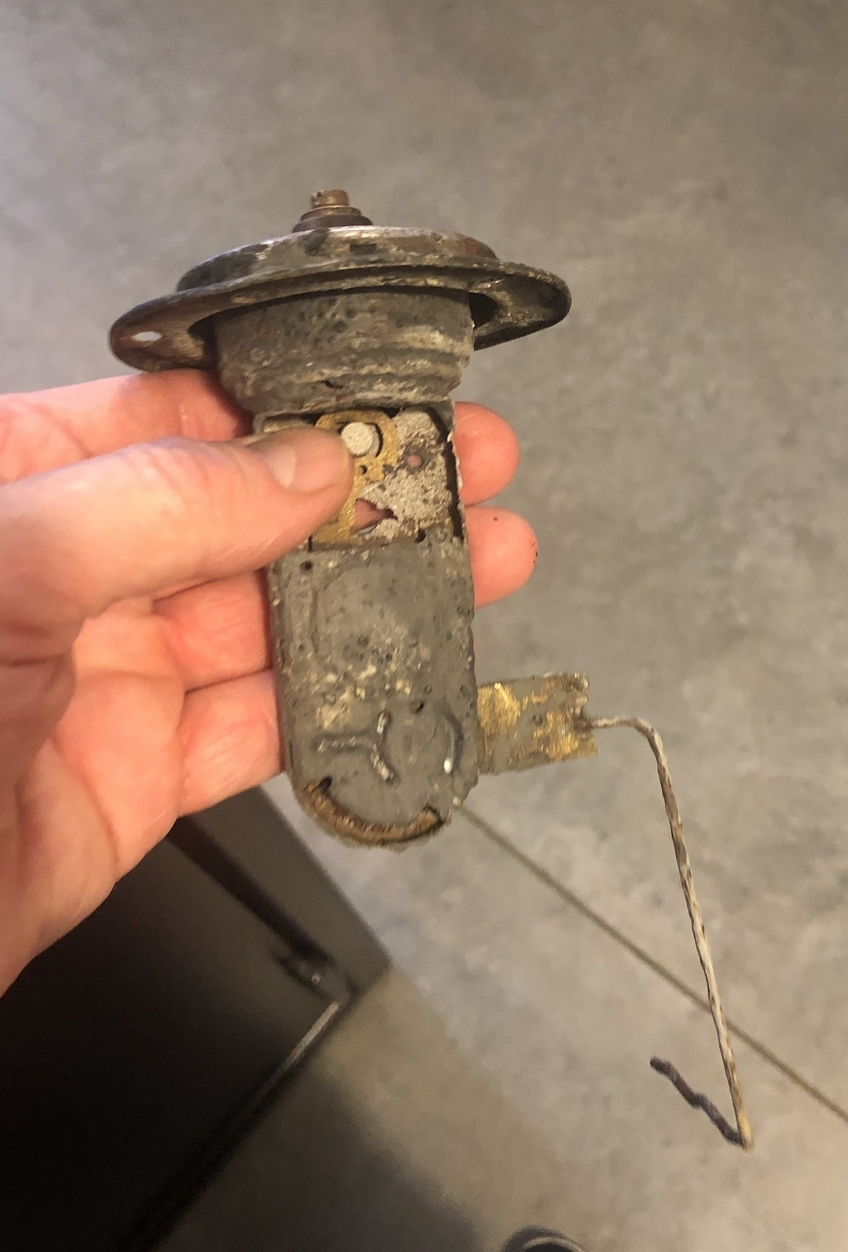 The unit I bought, where I cut off the bottom to fit in the tank;
The unit I bought, where I cut off the bottom to fit in the tank;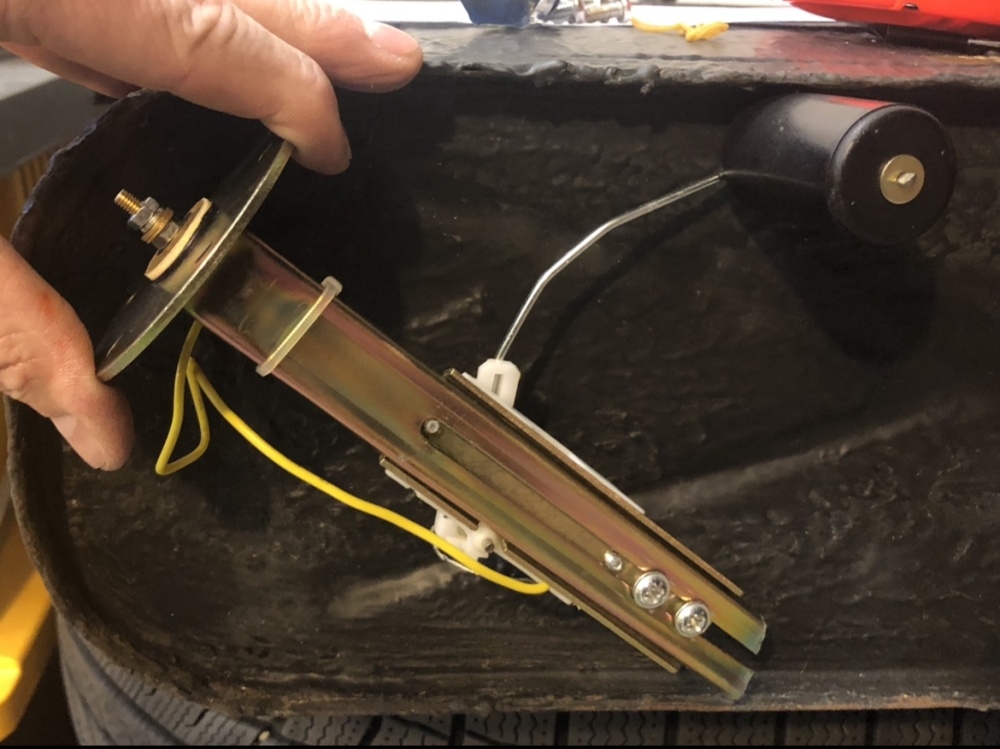
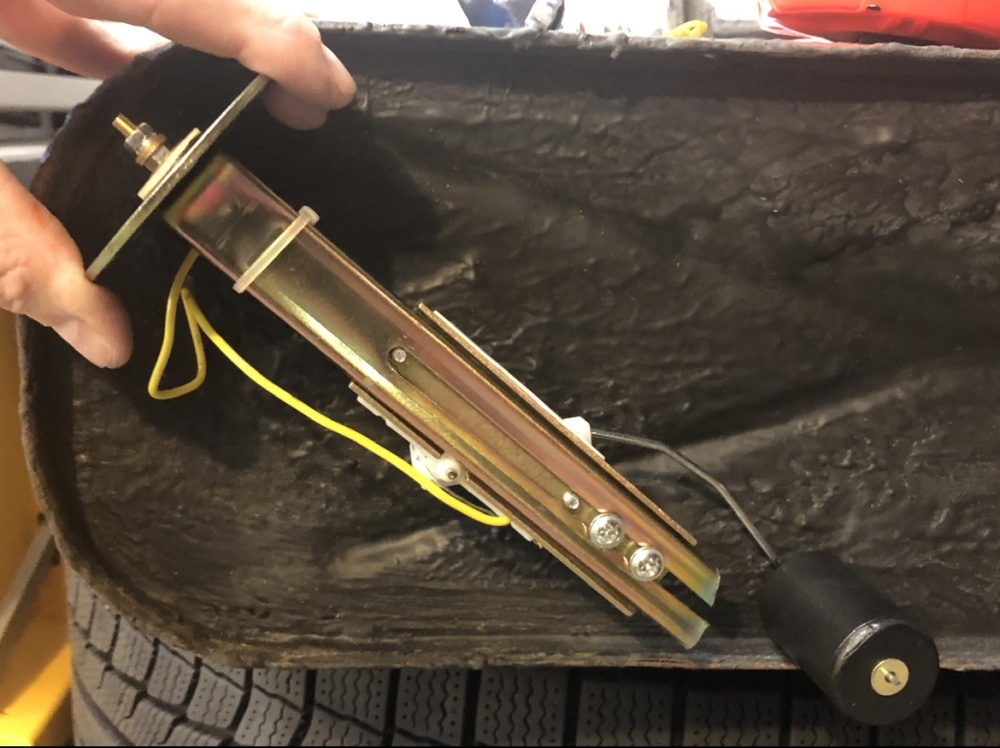 The finished product. To adjust the reading on your gauge all one needs to do is bend the arm some. I adjusted mine to error on the side of caution & showing my gauge on empty before it’s really empty.
The finished product. To adjust the reading on your gauge all one needs to do is bend the arm some. I adjusted mine to error on the side of caution & showing my gauge on empty before it’s really empty.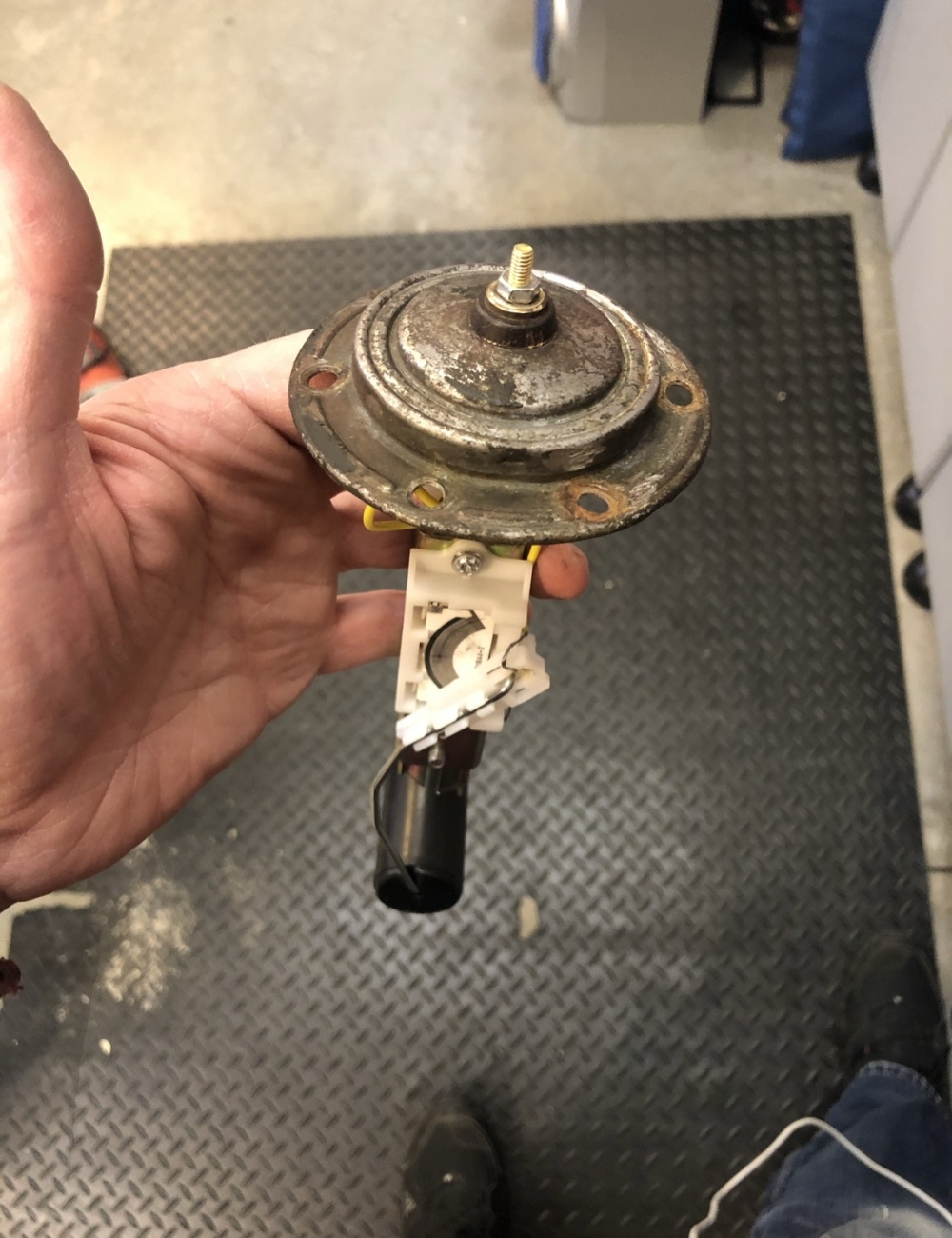 Use to seal up new gaskets;
Use to seal up new gaskets;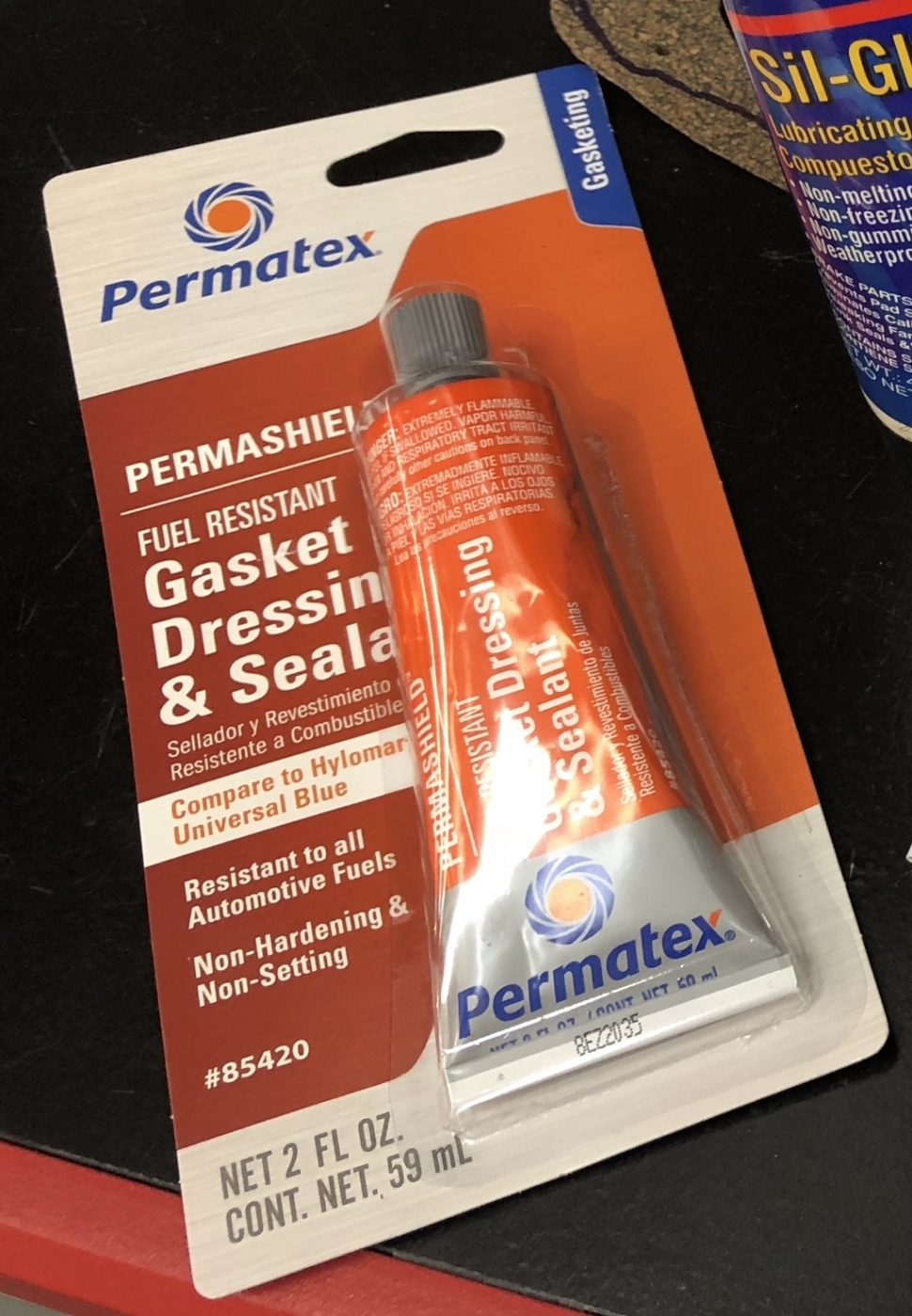
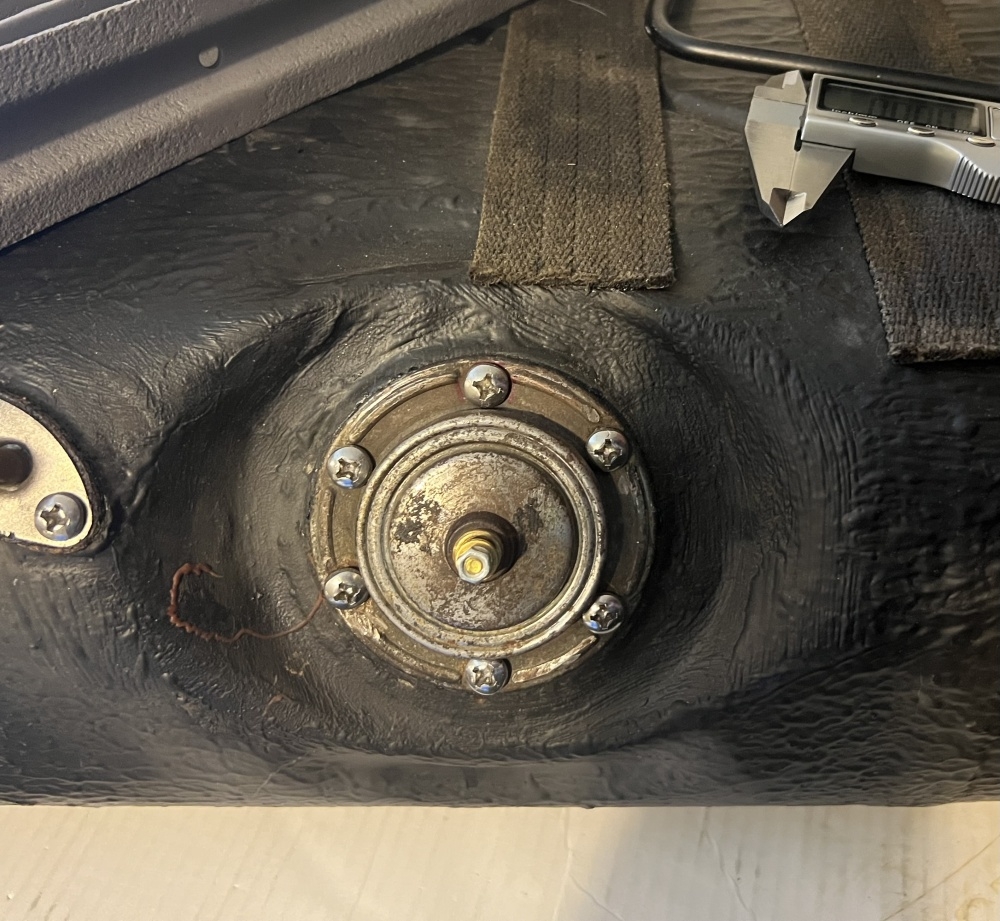 Here’s the unit I bought as well;
Here’s the unit I bought as well;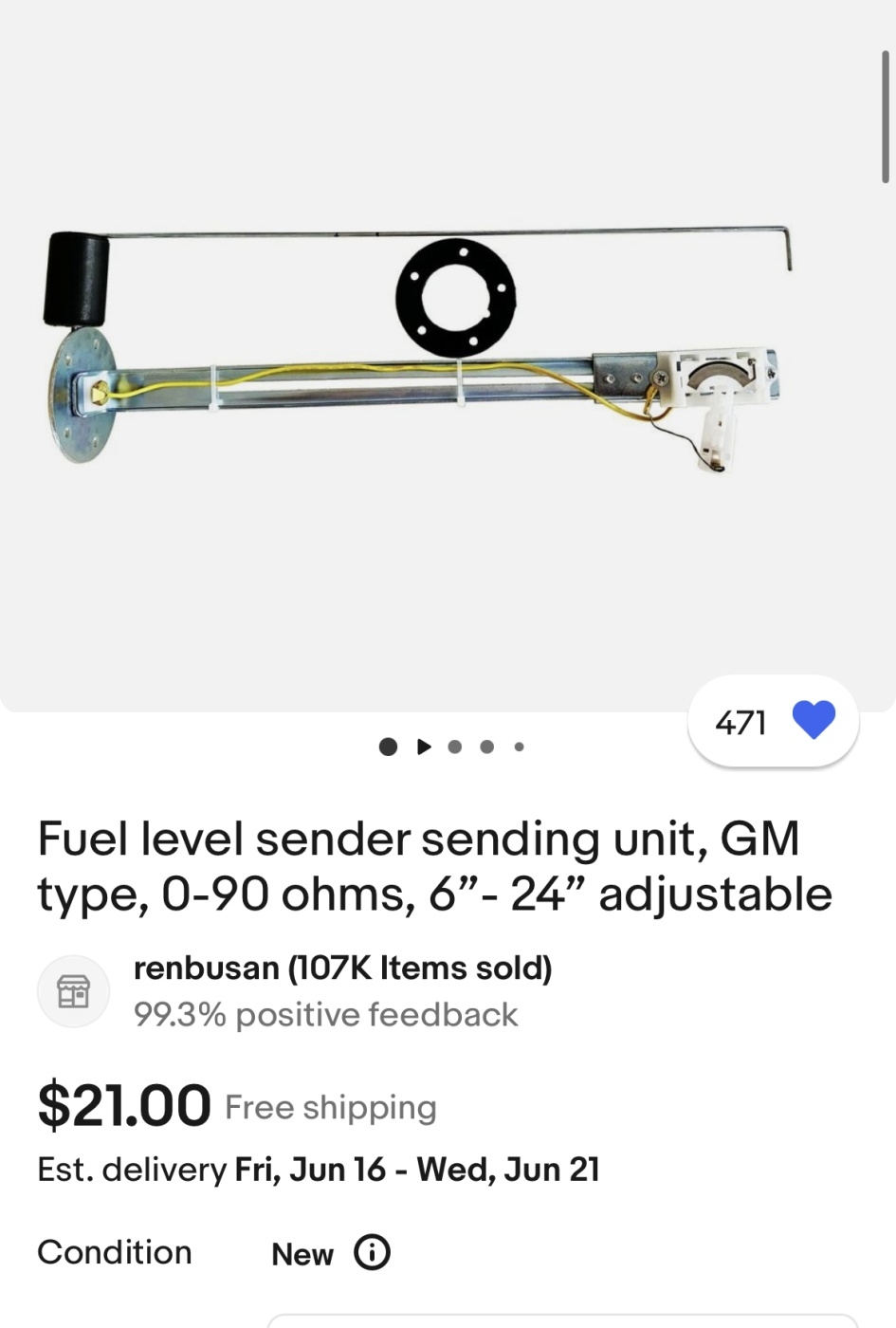 0
0 -
Wow! First of all, I can't thank you enough for posting all these photos as well as the technical information!
Questions:
Does the "new" sender that you devised, wire directly into the original 1937 dash gauge? (I understand that Hudson changed the type of fuel senders sometime between the late 1930's and the StepDown era, and wondered if your new replacement sender is compatible with the pre-war mode.)
Are you running 6 volt positive ground?
I can skip the next few questions!
In photo #6, is the top of the tank "up", and is the tank laying on the floor (table) flat, not up on end?
In photo #6 are the two screws that are closest together (1-1/8" apart on center) located at the 9:00 position? The 12:00 - 1:00 position? Or the 4:30 - 6:00 position?
In photo #6 does the float arm generally swing in the 12:00 to 6:00 orientation?
I will be grateful for any tidbits you can toss in my direction!
0 -
Another question: When you first started working on your gas tank / sender unit, did you find the sender properly installed in the tank, with the float arm moving vertically as it should? Or did you for some reason re-mount or otherwise modify the location of the sender hole (in the tank) or the metal ring on the tank with drilled holes for mounting the sender plate?
When I acquired my car, I discovered that only 3 screws held the sender to the tank. (The sender had evidently been rotated 90 degrees by a previous owner, and now only 3 of the 6 original screws could be attached.) The rest of the mounting holes on the tank were no longer in alignment with the holes on the sender, since the sender had been rotated. Very, very strange!0 -
Yes, running 6volt positive ground, all wiring original & I wired the unit as factory had done & everything is factory original for the 1937 Hudson. Naturally before I did all the mods to it I crawled under the car, connected it without installing it, moved the arm & then checked the gauge reading. Once I knew it would work for the movement I was limited to, I modified it. I’m pretty sure I just pulled the ring at top of the new unit & slipped the screw head through my original ring. Doing this I was able to align the ring to my tank then turn the internals to align for the proper movement of the arm inside the tank & positioning everything as I needed it.
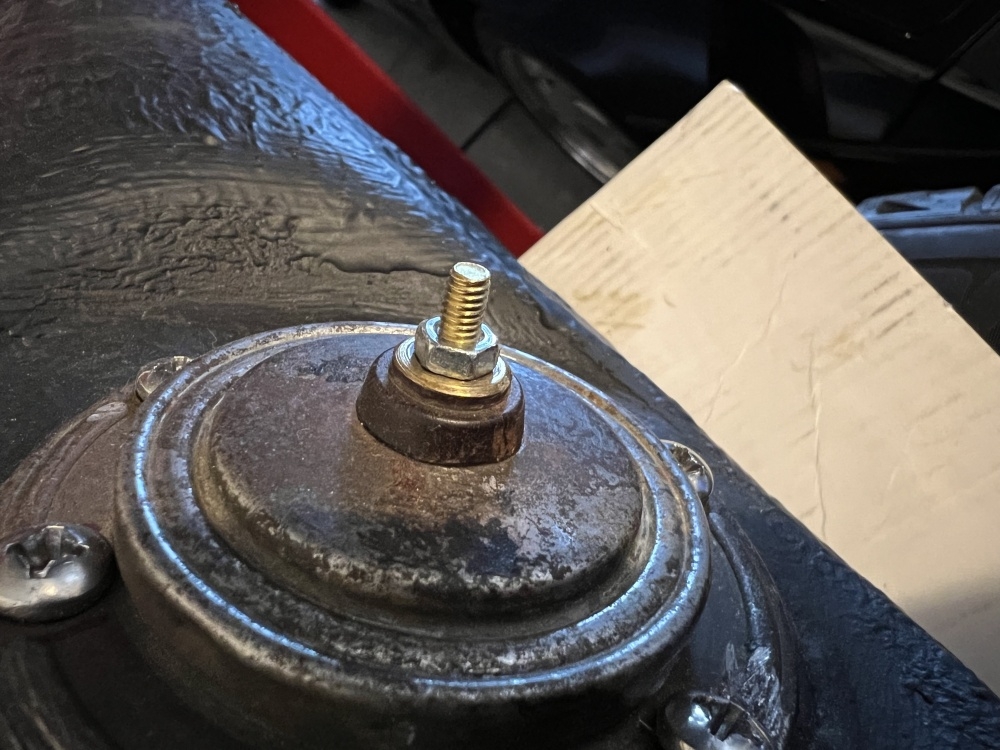
Here is the instructions that came with it & the parts I had leftover.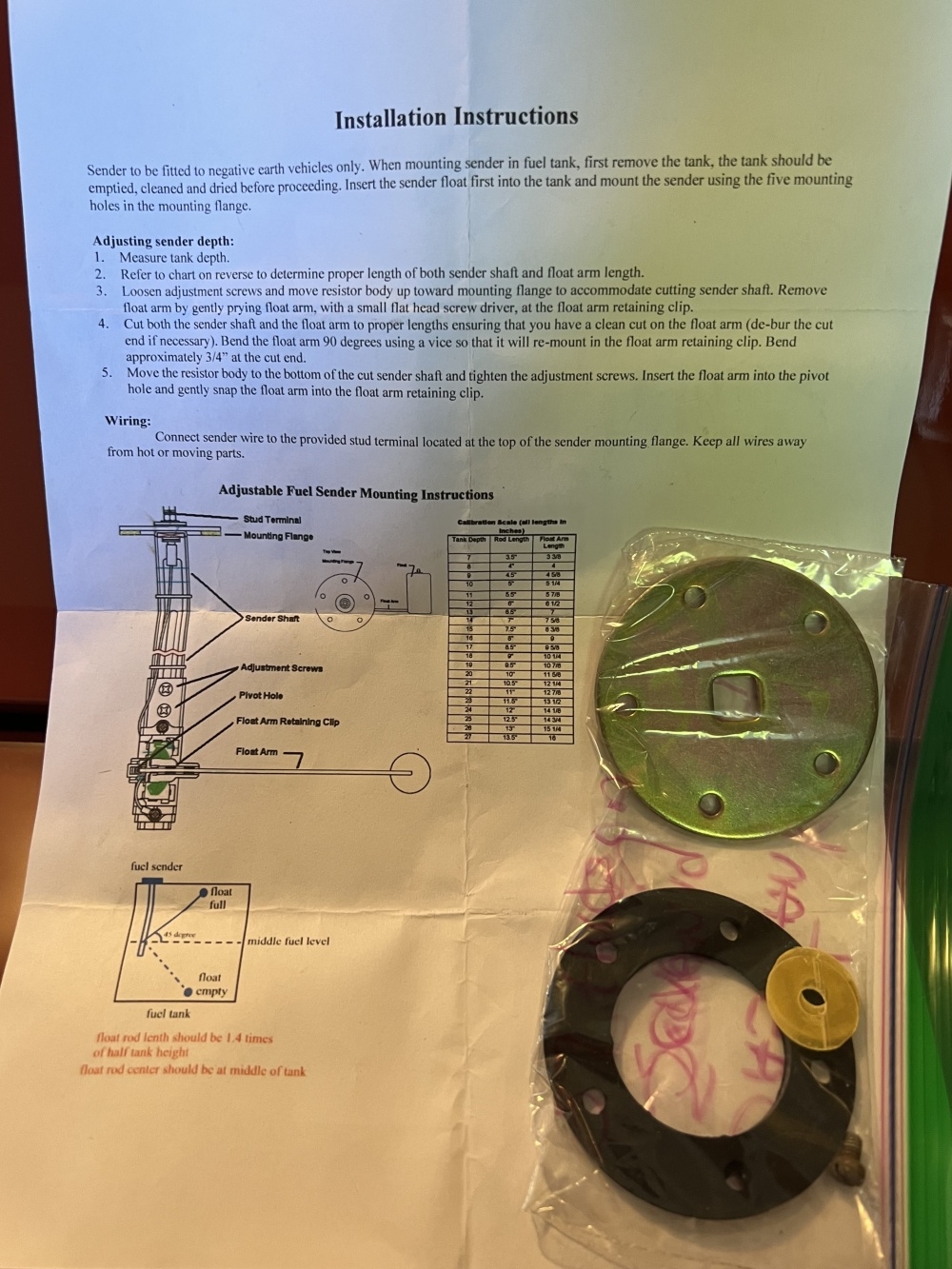 I made no modifications to the tank or the original sender top piece in that it bolts to the tank as original. The only thing I can’t find a picture of is if I soldered a wire to the underside of the original top piece. The wire would have been from the new unit. I have a vague memory of seeing a picture of this but will look for it. I’m not even sure if it was for this unit in the 37, but if the new one has a wire connected to the ring them maybe copy it's connected.I have a question for anyone reading this, what have others done to replace the donut that goes around the filler neck & between the trunk floor & the tank? My original,
I made no modifications to the tank or the original sender top piece in that it bolts to the tank as original. The only thing I can’t find a picture of is if I soldered a wire to the underside of the original top piece. The wire would have been from the new unit. I have a vague memory of seeing a picture of this but will look for it. I’m not even sure if it was for this unit in the 37, but if the new one has a wire connected to the ring them maybe copy it's connected.I have a question for anyone reading this, what have others done to replace the donut that goes around the filler neck & between the trunk floor & the tank? My original,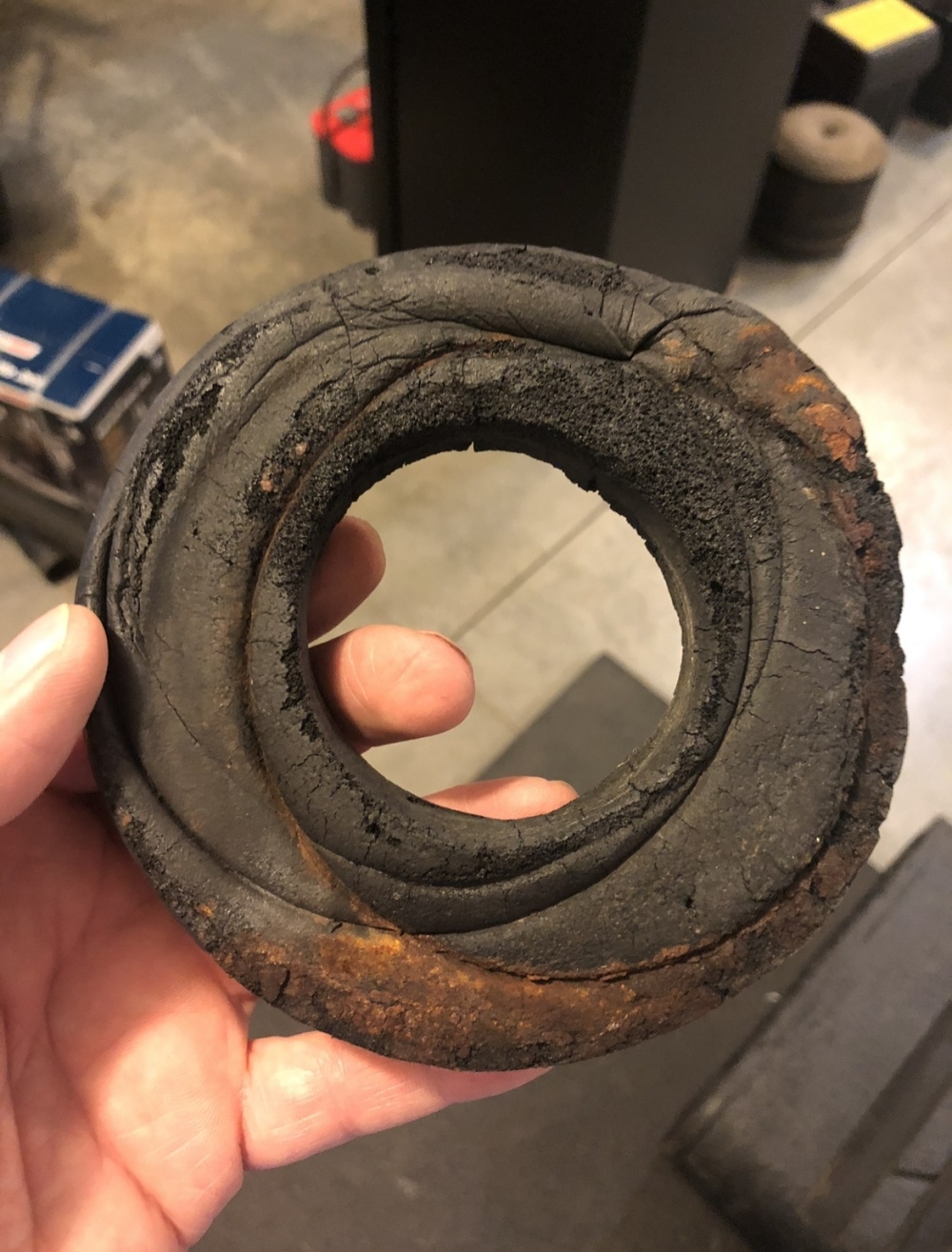 0
0 -
Thank you once again for all this information, photos, and above all your patience and helpfulness. I need to process all of this information, then I may be back for some follow-up questions!
Here's my bizarre situation: my tank is (as far as I know) original. And my old (now broken) sender is original (thanks for confirming that!). But when one screws the original sender to the original tank (with the 6 mounting holes aligned), the orientation of the float arm is incorrect! (How could this possibly be?) Anyway, some previous owner solved the problem by rotating the sender to the correct position. The 6 screw holes no longer aligned in that position, but he was able to find 3 screw holes that still aligned with one another. So, using only 3 screws, he fastened the sender in place. Somehow, that "fix" worked for well over 5 decades! Since I want to attach the new sender with all 6 screws, I will punch 6 new holes in the sender's mounting flange, tucked in amongst the existing 6 holes, but now oriented so that the sender's float arm will be correctly aimed. (Indeed, it will then become a "very holey" flange!)0 -
Glad I could help you!I understand the oddity of the prior guy using only 3 screws. Question; If you could align the sender top cover so that all 6 holes align with the tank’s original holes, will it screw in? If the answer is yes then you will be able to buy the sender & attach it as I had done with mine. It will allow you to orient the internals as you need before you fully tighten the sender to your old sender top cover. Notice I have one nut at the base of the threads coming thru the sender, that is to hold the orientation I wanted for the internals. Then when I attach the wire I have 2 small brass flat washers & another nut to top it off. I hope this all makes sense & at the very inexpensive price of $21 for the sender, I’d say it’s worth buying one & give it a go.If you need me in a short time frame, send me an email as I don’t check the forum often if I get busy on projects.0
-
Thanks, I'll keep your suggestion in mind. However, a couple of months ago I contacted Ken Ufheil when my old sender broke, and he fixed me up with a new sender. It all seems to work very well when being bench tested.
The problem still remains, that neither the old original sender or the new one, are not oriented correctly when fastened to the tank with all six screws. (Not Ken's fault; it's the incompatible screw hole patterns in the tank and the sender, which none of us could have foreseen.) Sadly, the sender can't simply be rotated 90 degrees in the tank and re-attached, because the asymmetrical screw pattern permits no rotational adjustment.
At this point I'm so far along on the project, that I'd rather not switch horses (or fuel senders) in the middle of the stream. (But thanks for your suggestion to use the same sender you're using.)
So my plan is to simply punch an array of 6 new holes in the mounting flange of the new sender, in a pattern that's re-aligned so as to permit bolting the float arm in the correct orientation. The new hole pattern will happily coexist with the old one, already on the flange. There's plenty of space for all 12 bolt holes, with no hole interfering with its neighbor.
It still astonishes me that a genuine 1937 Hudson sender cannot be correctly fastened to a genuine 1937 gas tank! I can only assume that someone screwed up the hole pattern, when my gas tank was fabricated.
0 -
Ok, so this is a totally different situation than what I understood!
So based on what you have & want to do it’s an easy fix. Have an Adapter Plate made! Here is an example of one. Ken may even be able to make one for you.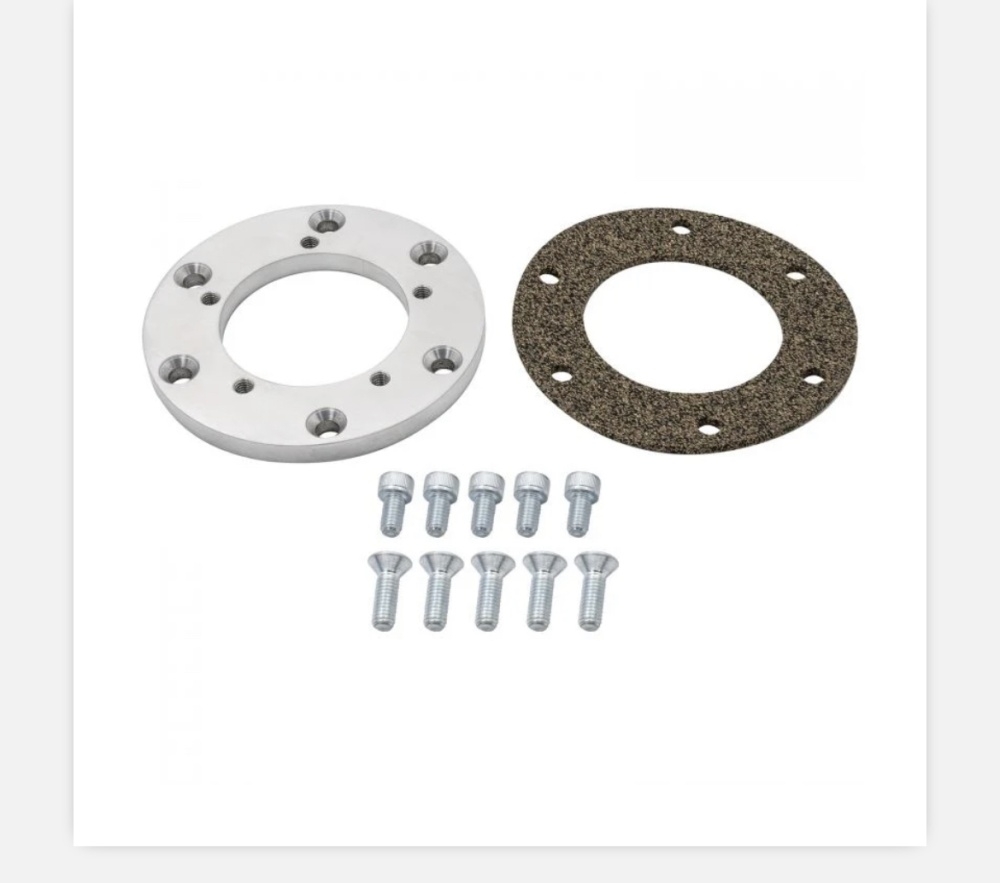
0 -
Thanks for the suggestion, and I'm sure that Ken could do a splendid job. But right now I'm planning to simply punch out a new set of 6 screw holes in the sender's existing mounting flange. The flange is made of thin steel, so should be easy to punch or drill. The new set of holes (laid out in the original asymmetrical pattern) will be rotated 90 degrees on the flange, so that the float rod is correctly aligned within the tank. The new holes will not interfere with the old ones.
I'm still at a loss to understand why a 1937 Hudson sender won't fit a 1937 Hudson gas tank correctly! (Unless the sender was made by a manufacturer who supplied several different auto companies with senders that were identical except for their orientation on the gas tanks!)0 -
This one does, because we bench tested it. It was adapted to work with the original gas gauges by Ken Ufheil (H-E-T member) by the addition of a "gizmo" that is wired between the sender and the dash gauge. So, you are correct: a modern gasoline sender will not work with the original gauges -- unless modifications have been made.0
-
Not sure what one means by “Modern Gasoline Sender”. Either way, what I can tell ya is that the one I bought, adapted & am using works perfectly in my original 37 Hudson.0
-
The early to mid-thirties Hudson’s and Terraplanes used ‘heated wire’ elements in both the sender and gauge. I believe that ended in ‘35 with later models using a resistive element0
-
Not so. Bi-metal gauges and sender units were used up until the 1950 models incl. . From 1951 onwards a voltage regulated system was used, with a bi-metal gauge and resistor sender unit.0
-
I stand corrected. Thank you, Geoff0
-
FWIW I have a universal resistance type sender installed in a 35 H8 and it cooperates nicely with the gauge.0
-
I do not know what a GIZMO is that Jon speaks of... but there are several methods of using modern sending units or the tried and true aftermarket ones with the HUDSON OEM fuel tank gauges. the attached Fuel Guage matching PDF provides information about available matching devices. In the scheme of things the cost to purchase one of these devices is inexpensive when compared to the cost of restoring an original sending unit. It also allows any car person to match gauges to the sender quickly.
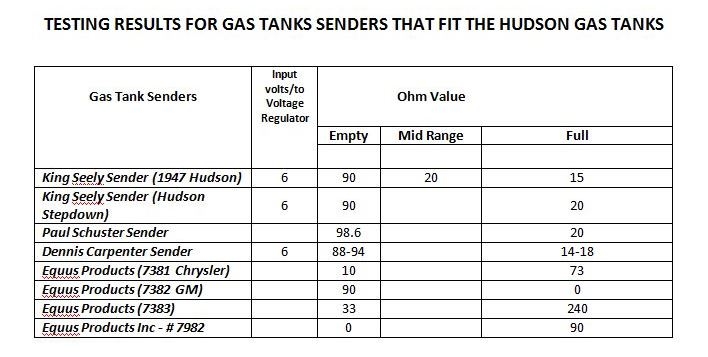 This information can be found on the FUEL SYSTEMS page on my Stepdown website:
This information can be found on the FUEL SYSTEMS page on my Stepdown website:
https://hudsonrestoration1948-54.com/
Cheers
Ken Cates
0 -
Great information Ken, thank you. I have repaired the bi-metal sender units, but it takes many hours fiddling to get right, with no guarantee of accuracy. And Murphy's law states "If you fiddle with a thing long enough, it will ultimately break"0
-
Thanks, all, for your many thoughts, photos, and contributions to this discussion. I hope it will present valuable information to those considering replacing their fuel senders in the future.
Just one more question: when replacing an old sender with a new one, how are you all adjusting the "travel" of the float arm within your tank, to achieve some accuracy at the dash gauge? I would think it's impossible to manage to get it to read "FULL" when exactly full, and "EMPTY" when it's reached the last drop.
(Impossible, and impractical, too: you always want the tank to have a bit of gas left, when your gauge points to "EMPTY".)
Would you actually put just a gallon of gas (for example) into an empty tank, wire the sender to the dash gauge, then repeatedly insert the sender and bend the float arm slightly, until the dash gauge reads "EMPTY"? That would define a reading of "EMPTY" as saying "you have one gallon left" but when you then fill your tank completely, would the gauge read precisely "FULL"? Each sender has its own particular range of travel, from empty to full, doesn't it? Would that automatically coincide with your tank's range?
0 -
Timely article from SPEEDWAY MOTORS concerning this topic:
https://www.speedwaymotors.com/the-toolbox/how-to-select-the-correct-fuel-gauge-and-sending-unit/120121?utm_content=saturday-hero&utm_source=Iterable&utm_medium=email&utm_campaign=campaign_6977997
0 -
That's the same as the one out of my 37 and 39 coupe.
0 -
Jon, you can figure out how to adapt the new sender on the kitchen table. Draw the profile of the end of the tank on a piece of cardboard or thin plywood etc. Position your new gauge on the template, adjust the arm length, travel and angle as required.0
-
I cannot give a simple answer because I haven't the foggiest idea how it works. Ohms are involved, I'm pretty sure. I got a sender from Ken Ufheil that he modified by the installation of a "black box" between the sender and the dash gauge. (I won't divulge its contents; that's Ken's proprietary information.) The original 1937 gauge was retained. We had initial problems trying to achieve the full range of the needle, from Empty to Full, during bench testing. Ken suggested bending back one or both of the "stop tabs" on the sender which limited the float arm's range. Thus unfettered, the float arm (and the gauge needle) did a full sweep, going from E to F. Worked like a charm.
In order to visualize the correct adjustment (or "bend") of the float rod inside the tank (we couldn't see it, of course), I made a very simple bracket to hold the flange of the sender at exactly the correct angle as when it was bolted in the tank. (Bracket = wood block, punched steel strap from hardware store, two flat head wood screws.) Then I placed the bracket -- with sender attached to it in the same position as if it were inside the tank -- at the side of the tank. Now I could see the swing of the float projected against the outside of the tank, allowing me to bend the float arm as necessary, so that the float would just hit the top of the tank at "Full" and the bottom, at "empty".
Then I hooked the sender to the wire that runs from the dash gauge back to the gas tank and turned on the ignition. At this point, it was just a case of swinging the float arm up and down while watching the dash gauge, bending the rod slightly, and swinging the float up and down again.
The big problem we pre-War owners have, is that most of the technical info about repairing gas senders is written about StepDowns. Pre-War Hudsons are a different animal.0 -
Old Fogey UK Posts: 1,022Expert AdviserI'm confused here.
Please can someone give me a definitive answer to the question - will a modern "ohm resistance" sender work with the 1930s "bi-metallic" fuel gauge?
The definitive answer is: NO the reason can be decerned from reading the attached extract of pages from the Hudson manual describing how the bi-metal strip in the fuel sender gauge functions in conjunction with the bi-metal strip in the fuel tank sender.
Hope this helps.0 -
My definitive answer is yes. The bi-metal strip sender and the variable resistance sender are 2 different devices that provide the same information to the gauge.
Not all variable resistance senders are created equal, I have a post or two on here re the range of resistance needed to communicate with a mid 30s fuel gauge. Plus there is a gotcha or two to be aware of.
I have a universal resistance sender from Dakota Digital (bolts straight into a 34/5 fuel tank) that is talking nicely to the fuel gauge on our 35 H8.
0 -
There is a device called Gauge Wizard, that you can buy, that will allow any gauge to work with any sender. You will have to google it.0
-
Unfortunately GlowPlug is definitively wrong!
The stock 1937 gauge works & is 100% accurate with the modern fuel sender, I have the working proof in my 37.I’ve spelled out exactly what part to use & exactly what one needs to do with detailed photos, just look at my earlier posts in the discussion. You can use this or not but anyone telling you otherwise is wrongfully arm chair quarterbacking, where I have done the work & have the actual proof it works.0
Categories
- 36.9K All Categories
- 113 Hudson 1916 - 1929
- 20 Upcoming Events
- 92 Essex Super 6
- 28.6K HUDSON
- 574 "How To" - Skills, mechanical and other wise
- 995 Street Rods
- 151 American Motors
- 178 The Flathead Forum
- 49 Manuals, etc,.
- 78 Hudson 8
- 44 FORUM - Instructions and Tips on using the forum
- 2.8K CLASSIFIEDS
- 608 Vehicles
- 2.2K Parts & Pieces
- 77 Literature & Memorabilia
- Hudson 1916 - 1929 Yahoo Groups Archived Photos
